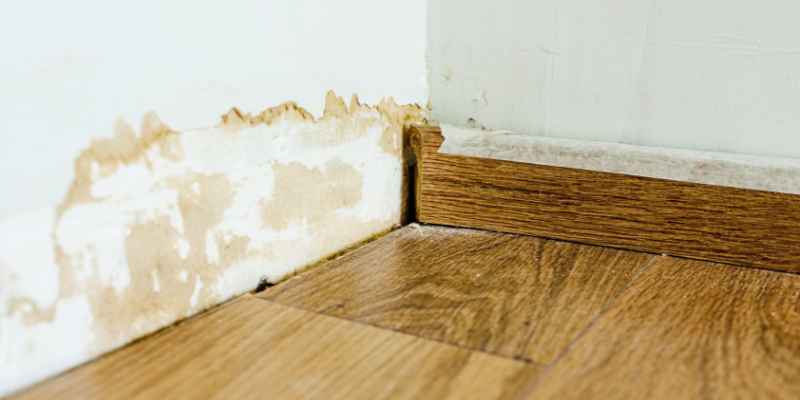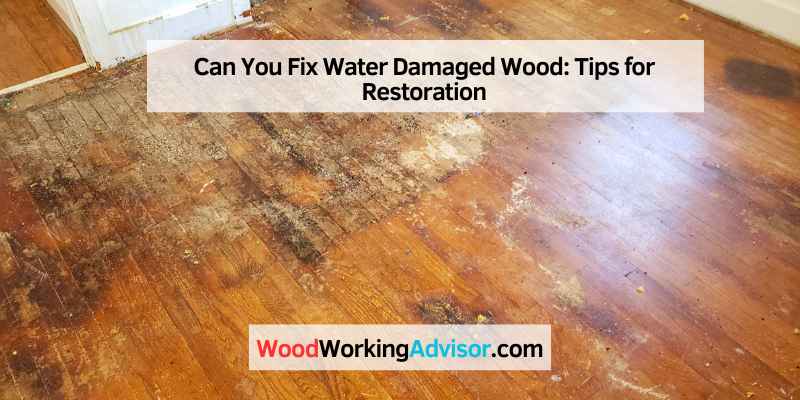Water damaged wood can be fixed by removing swollen areas, sanding, applying wood filler, and finishing with furniture oil. Water stains on wood are not always permanent and can be treated effectively.
Water damage on wooden furniture can often be repaired by following specific steps to restore its original condition. Whether it’s caused by spills, excess moisture, or other factors, knowing how to address water damage promptly can save your wood furniture from permanent harm.
By understanding the right techniques and using the correct products, you can successfully fix water damage on wood and preserve the beauty of your furniture for years to come.
Understanding Water Damage On Wood
Water-damaged wood can often be fixed with appropriate steps. Sanding, applying wood filler, and finishing with furniture oil can help remove swollen wood, bulging paint, and water stains. Gently buffing out water stains with a mild abrasive like toothpaste or baking soda paste can also help restore the wood.
Understanding Water Damage on Wood
Wood is vulnerable to water damage, which can compromise its structural integrity. Understanding the causes and effects is crucial in repairing water-damaged wood effectively.
Causes of Water Damage
The primary causes of water damage on wood include leaks, high humidity levels, and direct exposure to water. These elements can lead to swelling, warping, and mold growth on the wood surface.
Effects of Water Damage on Wood
Water damage on wood can result in swelling, discoloration, decay, and mold growth. These effects not only affect the aesthetics but also weaken the wood structure over time.
To repair water-damaged wood, identify the extent of damage, remove swollen areas, clean the surface, apply wood filler, and finish with furniture oil for protection.
Remember, acting promptly is vital to prevent further damage to water-exposed wood surfaces.
Assessing The Damage
When it comes to water-damaged wood, the first step is to assess the extent of the damage to determine if restoration is possible. Identifying the extent of the damage and determining if restoration is possible are crucial steps in the process.
Identifying The Extent Of Damage
Water damage to wood can manifest in various ways, including discoloration, warping, mold growth, and structural weaknesses. Identifying these signs is essential to understand the full scope of the damage.
Determining If Restoration Is Possible
After evaluating the extent of the damage, it’s important to determine if restoration is feasible. Factors such as the type of wood, the severity of the damage, and the presence of mold or rot will influence this decision.
Water-damaged wood can often be salvaged through proper restoration techniques, but in some cases, the damage may be irreparable, necessitating the replacement of the affected wood components.
Preparing The Surface
Before proceeding with fixing water-damaged wood, it’s crucial to prepare the surface properly. This involves removing swollen wood and water stains, as well as cleaning and sanding the surface to ensure a smooth and even finish.
Removing Swollen Wood And Water Stains
To start, carefully remove all swollen wood, bulging paint, and water stains using a suitable tool such as sandpaper or a putty knife. Once the damaged areas are cleared, it’s essential to clean the surface thoroughly using a brush and apply wood filler to the affected areas. Allow the wood filler to cure before proceeding to the next step.
Cleaning And Sanding The Surface
After removing the damaged portions, it’s time to clean the surface using appropriate cleaning agents to ensure all debris and residues are removed. Once the surface is clean, proceed with sanding the new surface until it’s even, using progressively finer sandpaper grits to achieve a smooth finish.
Once the surface is sufficiently smooth, it’s recommended to apply a suitable furniture oil or finish to restore the wood’s appearance and protect it from future damage.
Repair Techniques
Repair techniques can address and restore water-damaged wood effectively. By removing swollen areas, sanding, applying wood filler, and finishing with furniture oil, the wood can often be repaired and renewed. Maintaining the original wood grain while applying these methods can help restore the wood to its former state.
Applying Wood Filler
To fix water-damaged wood, start by applying wood filler into any cracks or holes. Smooth it out before it dries to ensure a seamless finish.
Using Moisture Barrier Products
It’s crucial to use moisture barrier products to protect wood from future water damage. Apply these products to seal the wood and prevent further issues.
In case of water-damaged wood, remove swollen areas with sandpaper and apply wood filler. Wait for it to cure and sand the surface evenly before finishing with furniture oil.
Refinishing The Wood
When it comes to fixing water damaged wood, refinishing the surface is one of the most effective methods. Refinishing not only restores the appearance of the wood, but also helps protect it from future damage. Here are a few steps to guide you through the refinishing process:
Choosing The Right Finish
Before refinishing the wood, it’s important to choose the right finish that will provide both aesthetic appeal and durability. There are various options available, such as paint, stain, sealant, or varnish. Here’s a breakdown of each:
| Finish Type | Description |
|---|---|
| Paint | A solid color finish that provides excellent protection against moisture |
| Stain | A translucent finish that enhances the natural beauty of the wood while offering some protection |
| Sealant | A clear finish that adds a protective layer to the wood, preventing water damage |
| Varnish | A durable and glossy finish that provides superior protection against water and other forms of damage |
Applying Stain Or Paint
If you choose to apply stain or paint, start by preparing the wood surface. Sand it down to remove any rough spots or imperfections. Make sure the surface is clean and dry before applying the stain or paint. Use a brush or a roller to evenly spread the stain or paint in the direction of the wood grain. Allow it to dry completely before applying a second coat, if desired. This will help achieve a smooth and uniform finish.
Applying Sealant Or Varnish
If you decide to use sealant or varnish, it’s important to follow the manufacturer’s instructions for application. Start by sanding the wood surface to create a smooth and even base. Remove any dust or debris with a clean cloth. Using a brush or a roller, apply the sealant or varnish in thin, even coats. Be sure to let each coat dry completely before applying the next one. This will help create a strong and protective layer on the wood surface.
By following these steps and choosing the right finish, you can effectively refinish water damaged wood and restore its beauty and longevity. Remember to take your time and follow the instructions carefully to achieve the best results.
Preventing Future Water Damage
If you’re wondering if you can fix water-damaged wood, the answer is yes. By removing swollen wood, using sandpaper or a putty knife to remove water stains, and applying wood filler and furniture oil, you can restore your water-damaged wood furniture.

Using Protective Coatings
Protective coatings are essential in preventing water damage to wood. Applying a waterproof sealant or stain can create a barrier against moisture, preventing it from penetrating the wood’s surface. These coatings not only serve as a protective shield but also enhance the wood’s natural beauty.
When choosing a protective coating, opt for products specifically designed for wood. Look for options that offer long-lasting protection and UV resistance. Apply the coat evenly, making sure to cover all surfaces of the wood. Don’t forget to follow the manufacturer’s instructions for drying times and reapplication.
Proper Care And Maintenance
In addition to using protective coatings, proper care and maintenance are crucial for preventing future water damage to wood. By taking the following measures, you can ensure the longevity of your wood furniture and surfaces:
- Wipe up spills immediately: Accidents happen, but it’s important to clean up any spills promptly to prevent water from seeping into the wood. Use a soft cloth or paper towel to absorb the moisture.
- Avoid excessive water exposure: Keep wood away from areas prone to moisture, such as bathrooms, kitchens, and laundry rooms. If there’s unavoidable contact with water, make sure to dry the wood thoroughly afterwards.
- Control humidity levels: Excess humidity can cause wood to swell and warp. Use a dehumidifier or ensure proper ventilation in spaces where wood is present to maintain stable humidity levels.
- Use coasters and placemats: When placing drinks or hot dishes on wooden surfaces, use coasters and placemats to protect them from direct contact with moisture or heat.
- Regularly inspect for signs of damage: Periodically check your wood furniture and surfaces for any signs of water damage, such as discoloration, warping, or mold growth. Catching these issues early on can prevent further damage.
By following these preventative measures, you can extend the lifespan of your wood and keep it looking beautiful for years to come.
Frequently Asked Questions Of Can You Fix Water Damaged Wood
Is Water Damage On Wood Permanent?
Water damage on wood is not always permanent. Water stains caused by spills or hot dishes can be removed with proper techniques. Sand the surface, apply wood filler, and finish with furniture oil. However, be cautious not to damage valuable pieces.
How Do You Fix Water Damaged Swollen Wood?
To fix water damaged swollen wood, remove swollen parts, water stains, and paint. Sand, apply wood filler, let cure, sand evenly, and finish with furniture oil.
How Do You Remove Water Damage From Wood?
To remove water damage from wood, sand the affected area to remove bulging paint and water stains, then apply a wood filler. Wait for it to cure, sand the surface, and finish with furniture oil. Alternatively, gently buff out water stains with a mild abrasive like toothpaste or baking soda paste.
Is Wood Ruined If It Gets Wet?
When wood gets wet, it can be prone to mold and rot, and may swell from increased moisture. Watermarks on wooden furniture can also occur. However, with proper care and repair, water damage to wood can often be fixed.
Conclusion
Water damage on wood is not always permanent. With the right techniques, stains and marks can be removed. Remember to be cautious and follow proper steps to avoid further damaging the wood. By taking the time to repair water damaged wood, you can restore its beauty and functionality.


